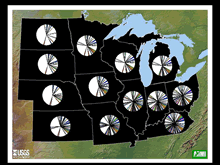- More than 5,504 known species living worldwide comprise the class Amphibia; 276 of those species live in the continental United States (Crother 2000; Frost 2002).
- Forty-two species
(53 including subspecies and hybrids) of salamanders [order
Caudata] live in the Midwest Region (UMR) of ARMI.
- Thirty-three species
(36 including subspecies) of frogs and toads [order Anura]
live in the UMR of ARMI.
|
|
- Because of the diversity of salamanders associated with the physical and biological conditions in the southeastern part of our region, the number of species diminishes with distance from that area.
- For more information on the taxonomy, distribution, and ecology of species go to http://www.discoverlife.org/nh/.
|
Species of Conservation Concern
- Forty-one of the 89
species or subspecies (46%) in the Midwest Region of
ARMI warrant conservation concern by at least one of the 13 states.
These include 20 of the 53 species of salamanders (38%) and 21
of the 36 (58%) species of frogs and toads .These species are
either endangered, threatened, species of concern, or protected.
- No species from this region are listed under the Federal Endangered
Species Act of 1973 (http://endangered.fws.gov/).
- Differences between state and federal concern over the statuses
of species largely are because of two factors. State and Federal
regulators can have different criteria for evaluating the status
of a species. In addition, individual states often contain only
small portions of the historical distributions of species. This
can result in the populations living in a particular state becoming
threatened or endangered before populations throughout the entire
range.
Relevant and Cited Literature
Conant, R. and J.T. Collins.
1998. A field guide to reptiles and amphibians of eastern and central
North America. Third Edition, Expanded. Houghton Mifflin, New York.
616 pp.
Crother, B.I. (ed.) 2000.
Scientific and standard English names of amphibians and reptiles
of North America north of Mexico, with comments regarding confidence
in our understanding. Society for the Study of Amphibians and Reptiles.
Herpetological Circular No. 29. 82 pp.
Fischer, T.D., D.C. Backlund,
K.F. Higgins, and D.E. Naugle. June 1999. Field guide to South Dakota
amphibians. South Dakota Agricultural Experiment Station. Bulletin
733. South Dakota State University; Brooking. 52 pp.
Frost, Darrel R. 2002.
Amphibian species of the world: an online reference.
V2.21 (July 15 2002). Electronic database available at http://research.amnh.org/herpetology/amphibia/index.html.
Lannoo, M.J. 1998. Status
and conservation of midwestern amphibians. University of Iowa Press,
Iowa City. 507pp
Potts, G., J.T. Collins,
and K. Shaw. 1999. A checklist of the vertebrate animals of Kansas.
2nd Edition
Petranka, J.W. 1998. Salamanders
of the United States and Canada. Smithsonian Institution Press.
Washington, D.C.
Kentucky State Nature
Preserve Commission, 2004. Endangered, threatened, and special
concern species. http://nrepcapps.ky.gov/ksnpc/etsquery.asp
Species at risk in Kansas. 2004.
http://www.gpnc.org/threaten.htm
U. S. Fish and Wildlife Service. 2004. Endangered
Species Program. http://endangered.fws.gov/
|


